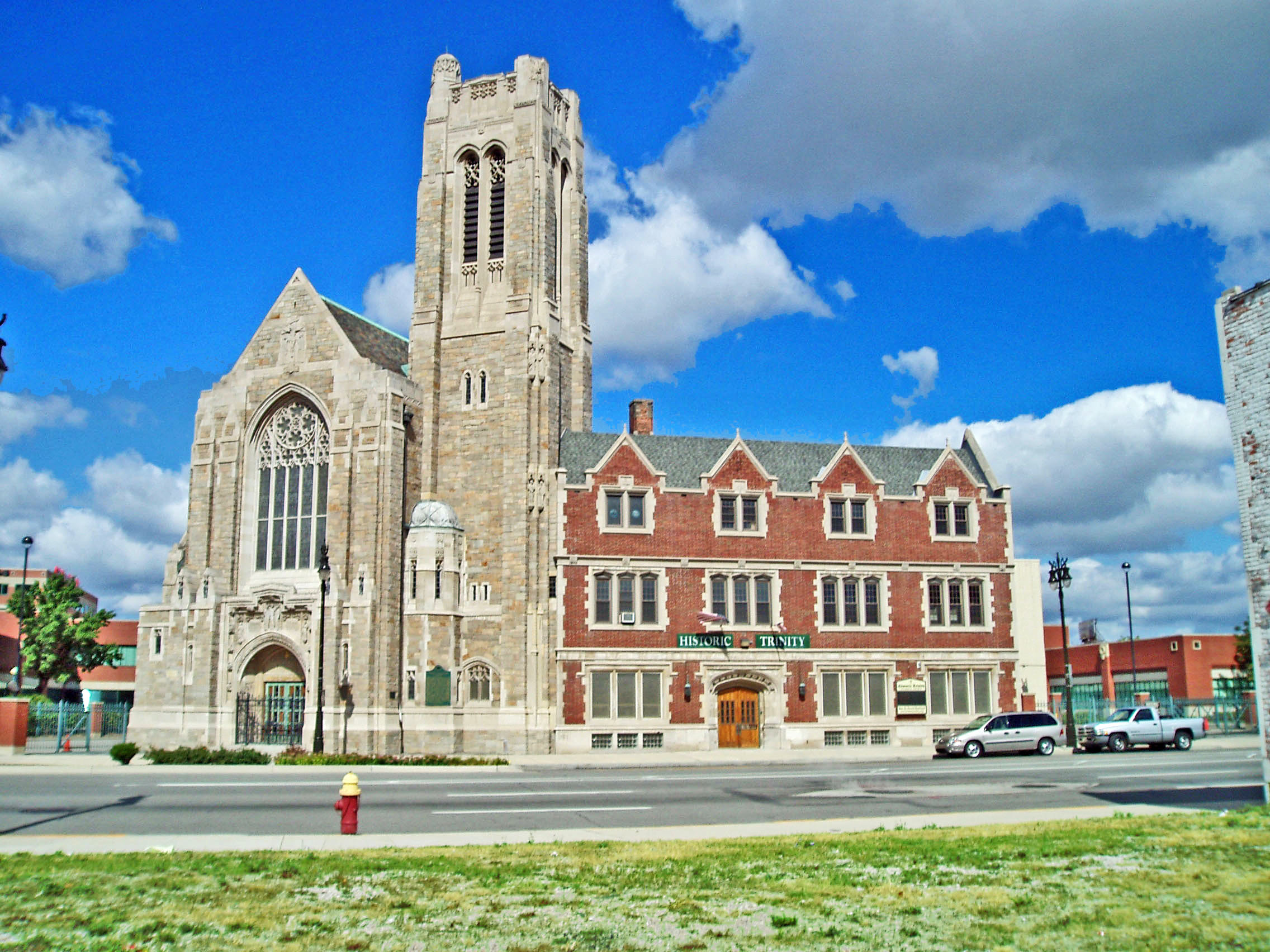

This graceful structure, completed just 80 years ago, was the final Gothic Church built in the city of Detroit. It is difficult to believe that future architects will invoke the Gothic style when they design the next generation of churches for the Motor City. Historic Trinity is also the most visible of the three German churches in the Eastern Market area just northeast of downtown Detroit. Francis Himpler’s magnificent Gothic St. Joseph’s Church—where Mass is still said in German on a monthly basis—is pretty well concealed on Jay Street while surrounding buildings hover over St. John’s-Saint Luke’s Evangelical Church on Russell near its intersection with Gratiot. It is still an active church but I wonder about its future since I have heard there are few young members of the congregation.
Detroit’s population was tiny in the early Nineteenth Century. Most of the residents were French Catholics. During the brief British occupation, there were too few people to establish an Anglican church. After the Erie Canal was completed in 1825, migrants could reach Detroit from the east coast and, gradually, the Protestant population grew. On August 18, 1833, the first Lutheran service in Detroit was led by the Reverend Fredrich Schmid in a carpenter’s shop close to the Detroit River. He did not spend much time in the city. Instead, he went to western Washtenaw County to establish Salem Lutheran Church, now located at 7474 Scio Church Road.
The first permanent Lutheran pastor in the city was John Fredrich Winkler from the Ohio Synod who established St. Matthew’s Lutheran in 1845 at the intersection of Congress and Rivard. In Germany, Lutherans were members of the German Evangelical State Church. They could not directly import that organizatitonal structure and their hierarchy to this county since the government did not support or organized religions. Partly as a result of the very different environment in the United States, the Lutherans set up or split into a variety of different synods, synods that did not always agree on organizational matters or hierarchy and that remain distinct.
Seventeen members of Reverend Winkler’s Ohio Synod St. Matthew’s Lutheran Church in Detroit broke away to form Trinity Lutheran on October 10, 1850. They affiliated with the Missouri Synod, a group organized just three years earlier. Reverend Johann Michael Gottlieb Schallar was the first pastor of this congregation whose third building is pictured above. This is the mother church of Missouri synod Lutheranism in the Detroit area. The congregation's first building was a structure they purchased and relocated to the corner of Larned and Rivard. In 1866, the congregation was sufficient prosperous to build a brick church at Russell and Gratiot where the church you see pictured above is located. This church was razed so that the new Gothic structure could be constructed.
The Revolution in German in 1848 combined with years of very poor harvests to propel an out-migration. Germans followed the Irish as the second major stream of European immigrants to come to the United States. From about 1850 to 1880; Germany, Ireland and Canada were the leading countries of origin of people migrating to rapidly developing Detroit. This explains the emergence of Lutheran churches, German Catholic Parishes and synagogues in Detroit. Several German enclaves developed in Detroit. The largest one was on the east side of the city extending northwest from the river along Gratiot, Russell and parallel streets.
Immigration from Germany to Detroit slowed to a trickle toward the end of the late Nineteenth Century and then came to an end before World War I. Until 1913, this parish used German for liturgical services but, after than, English was used. By 1920, Germans on the city’s east side were moving away to more substantial housing in the city’s outskirts and Trinity was no longer at the heart of a German community. Nevertheless, a prosperous and industrial member of the parish, Charles Gauss, played a major role in assembling the requisite funds for the beautiful religious complex that you see pictured above. I believe that he provided very much of the financing that was needed. Mr. Gauss was a wholesale tobacco merchant in Detroit and a real estate speculator. I believe he increased his wealth substantially when he sold land he owned along the River Rouge so that Henry Ford could expand his Dearborn facilities. Most impressive, of course, is the Neo-Gothic church constructed of Indiana limestone that William Hunter designed, a church that was dedicated in 1931. Hunter design was apparently strongly influenced by Reverand Webber of Cleveland who was an member of the Missouri Synod's committee on church architecture and a writer on this subject.
Membership fell again after World War II when federal housing programs and shifts in the location of employment accelerated the growth of the suburban ring. I infer that leaders of this parish and other Lutheran administrators considered their options since the church no longer served local communitys of congregants. However, they decided to remain and established a variety of programs designed to assist Detroit residents while proclaiming the Lutheran presence in downtown Detroit. At this time, I believe, they adopted the name and title Historic Trinity to describe the church.
Architect: William Edgerton N. Hunter
Date of Completion: 1931
Architectural Style: Neo-Gothic
For additional information and pictures of the interior, please see: Marla O. Collum, Barbara E. Krueger and Dorothy Kostuch, Detroit's Historic Places of Worship (Detroit, Wayne State University Press, 2012)
City of Detroit Designated Historic District: Listed November 26, 1979
State of Michigan Registry of Historic Places: P 4,489 Listed April 24, 1981
State of Michigan Historic Marker: Put in place on May 25, 1982. It is attached to the Gratiot front of this church.
National Register of Historic Sites: #83000897, Listed February 10, 1983
Website: http://www.historictrinity.org/
Use in 2012: Missouri Synod Lutheran Church
Photograph: Ren Farley: September 11, 2008
Description updated: December, 2012